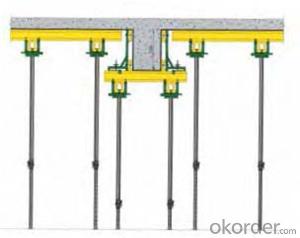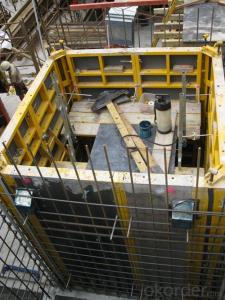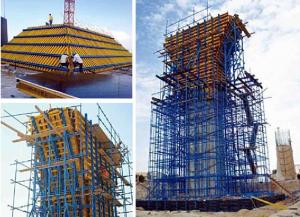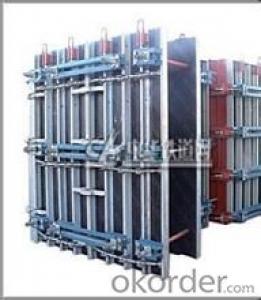Aluminum Scaffolding Platform Formwork Renting Scaffolding With New Design
- Loading Port:
- Tianjin
- Payment Terms:
- TT OR LC
- Min Order Qty:
- 6000 set
- Supply Capability:
- 50000 set/month
OKorder Service Pledge
OKorder Financial Service
You Might Also Like
Aluminum Scaffolding Platform Formwork Renting Scaffolding With New Design
Frame Scaffolding Systems Formwork Bs Standard Scaffolding Tube With Low Price
Developing with new technology materials, steel formworks is no longer a must in construction concrete process. More and more buildings are established with plastic formworks. And workers love this new formworks much more.
The advantages of plastic formworks:
1.First of all--light
Yes it is the first advantage of plastic formwork. It wins the great praise of both contractors and workers.
The biggest panel is 120×1500px,weights 10.5kg only. It can be lift and set up by one person easily, which means there is no need for cranes on site.Saves a lot of cost and time.
2.Easy set up
Different size of panels can firmly locked by simply turn the special handles to 90 degree. The Panels has rib on the back, which makes the system need not traditional wood blocks and nails. The panels have holes to fit tie rod, guarantee the strength of the whole system.
3.Modularity
Modular formworks composed by different size of panels,the main item is 120×1500px panel,which is used for the large area of walls and slabs. There are also small size of panels like 10×1500px,20×1500pxcm,25×1500px,inner corner 20×20×1500px and outer corner 10×5×1500px.Due to the variety of panel size, the system can form almost all size walls 120×1500px panel of multiply by 125px. The material of modular formwork is PC-ABS mixed with special glass fibers which enable panels to hold high pressures.
4.Strength
The handles are made by high strength Nilon, each panel locked by at least 4 handles, which makes the whole system strong enough to pour 1000px walls.
5.Environment friendly
The system needs no cut and nail due to the variety size. Also it needs nearly no wood. The material can be recycled after broken, so it will not pollute the environment.
6.Consequent
Concrete does not stick to plastic formwork, thus the panels need no oil before using, and can be cleaned simply by water. The surface of the wall which build by modular formwork is smooth and without rework.
Aluminum Scaffolding Platform Formwork Renting Scaffolding With New Design
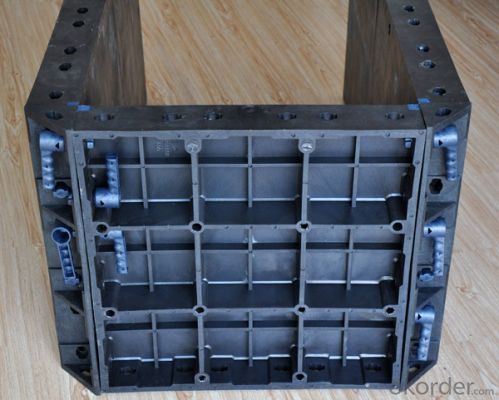
Aluminum Scaffolding Platform Formwork Renting Scaffolding With New Design
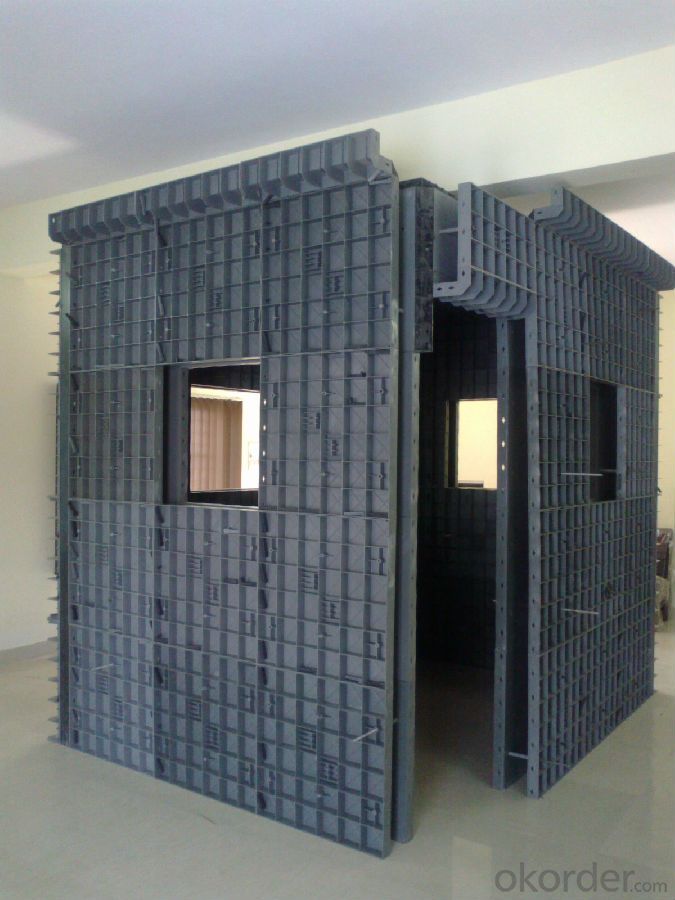
Aluminum Scaffolding Platform Formwork Renting Scaffolding With New Design

Advantage
* Good loading capacity
* Easy to assemble and dismantle
* Stable and durable thanks to its structual design & automatic welding quality
* Customized solution helps you work safe, save cost and convenient
* Excellent quality for formwork & scaffolding with wide choices
Packing
in bulk or in bundle, or as requested
Shipping
15-20 Days.
Normally small orders, it needs just 15-20 business days to the port. For goods with stock, it would be even shoter.
Aluminum Scaffolding Platform Formwork Renting Scaffolding With New Design
Other scaffolding & formwork products:
(1) Scaffolding System:
Including Ringlock Scaffolding System and accessories; Cuplock Scaffolding System and accessories; Kwikstage Scaffolding System and accessories; Haki Scaffolding System and accessories;
(2) Scaffolding Frame & Accessories:
Including Walk Through Frame Scaffolding; Ladder Frame Scaffolding; Accessories; we also can make scaffolding according to your samples or drawings.
(3) Scaffolding Couplers/Clamps:
We can produce all kinds of forged and pressed couplers, including British type couplers, American type couplers, German type couplers, Italian type couplers ,fence couplers, BRC coplers and so on. We also can produce according to your drawings or samples.
(4) Formwork System Scaffolding & Accessories:
Light Duty Shoring prop and Heavy Duty Shoring Prop; Wing nuts and Tie rods; RASTO clamp and so on.
FAQ Aluminum Scaffolding Platform Formwork Renting Scaffolding With New Design
Why Us?
We are one of the Top 500 in the world, largest construction materials supplier in China. Also we are a state-owned company and respond to every customer with large and also small orders.
We own professional manufacturers with powerful producing capacity.
Extensive and comprehensive quality control system
Excellent products with competitive prices.
Efficient services in pre and after sale.
Full energy with affluent experience team.
- Q:What are the different types of edge profiles used with steel frame formwork?
- Steel frame formwork commonly utilizes various types of edge profiles to enhance functionality and durability. One frequently used profile is the chamfered edge, which prevents concrete buildup and aids in formwork removal after curing. Another popular profile is the rounded edge, known for its smooth and curved shape that reduces injury risks and facilitates cleaning and maintenance. The beveled edge is a third profile option that minimizes sharp corners in concrete, reducing the chances of cracking or chipping at formwork edges. Moreover, certain steel frame formwork systems may incorporate a recessed edge profile, creating grooves or channels for the insertion of reinforcement bars or other structural elements. This ensures proper alignment and positioning within the concrete structure. In conclusion, different edge profiles, including chamfered, rounded, beveled, and recessed, are utilized with steel frame formwork systems. Each profile offers unique advantages in terms of concrete placement, formwork removal, safety, and structural integrity. The choice of edge profile depends on the specific requirements of the construction project.
- Q:How does steel frame formwork affect the quality of the finished concrete surface?
- The quality of the finished concrete surface can be significantly impacted by steel frame formwork. To begin with, the utilization of steel frame formwork guarantees precise and accurate alignment of the formwork, resulting in a straight and even concrete surface. This is especially critical for concrete structures that necessitate high levels of accuracy, such as walls, columns, and slabs. The rigidity and stability of steel frame formwork also prevent any movement or deformation during the pouring and curing process. This helps to eliminate any potential formwork deflection or concrete slump, resulting in a smooth and uniform finish. Additionally, the steel frame formwork provides exceptional support and containment for the freshly poured concrete, ensuring that it does not leak or sag. Furthermore, steel frame formwork allows for effortless removal and demolding of the formwork after the concrete has set. The smooth and clean surfaces of the steel frame minimize the risk of any marks, imprints, or surface defects on the concrete. This is particularly crucial for architectural concrete finishes where a flawless appearance is desired. Moreover, steel frame formwork offers a reusable and durable solution, reducing the overall construction cost and waste generated. The high-quality finish achieved with steel frame formwork also reduces the need for additional surface treatments or repairs, saving time and resources. In summary, utilizing steel frame formwork guarantees precise alignment, prevents movement or deformation, provides excellent support, and allows for easy removal. These factors contribute to a high-quality and aesthetically pleasing finished concrete surface, meeting the desired standards and requirements of construction projects.
- Q:How does steel frame formwork compare to fiberglass formwork?
- Steel frame formwork is generally considered to be more durable and long-lasting compared to fiberglass formwork. Steel offers excellent strength and load-bearing capacity, making it suitable for heavy-duty construction projects. Additionally, steel formwork can be easily reused multiple times, reducing costs in the long run. On the other hand, fiberglass formwork is lighter and easier to handle, making it more convenient for small-scale or temporary applications. However, its lower durability and limited load capacity make it less suitable for high-rise or large-scale projects. Ultimately, the choice between steel frame formwork and fiberglass formwork depends on the specific requirements and constraints of a construction project.
- Q:Can steel frame formwork be used for curved structures?
- Indeed, curved structures can be constructed using steel frame formwork. The versatility of steel frame formwork allows for effortless adjustments or modifications to form curved or intricate shapes. This is accomplished by implementing flexible plywood or metal sheets that can be flexed or contoured to conform to the desired curve. Moreover, steel frame formwork offers exceptional durability and steadfastness, rendering it suitable for erecting both linear and curved structures.
- Q:How does steel frame formwork accommodate for electrical and plumbing installations within the concrete structure?
- The use of steel frame formwork presents a flexible and efficient solution for accommodating electrical and plumbing installations within a concrete structure. This particular formwork type is designed for easy adjustment and customization, allowing for the creation of necessary openings and recesses. One of the main benefits of steel frame formwork lies in its seamless integration of various service installations. Through the utilization of steel frames, openings can be established during the formwork assembly process, enabling the insertion of electrical conduits, pipes, and other plumbing fixtures. These openings can be precisely positioned and aligned according to the desired layout of the electrical and plumbing systems. Moreover, steel frame formwork can be readily modified or adapted during the construction process in the event of changes or additions to the electrical or plumbing plans. This flexibility permits efficient adjustments without compromising the structural integrity of the concrete structure. Furthermore, steel frame formwork offers a secure and durable support system for electrical and plumbing installations. The steel frames are designed to withstand the pressure and weight of the concrete, ensuring the installations remain intact and in place both during and beyond the construction process. To summarize, steel frame formwork provides a versatile and accommodating solution for integrating electrical and plumbing installations within a concrete structure. Its adjustability and ability to create precise openings allow for seamless integration, while its flexibility enables easy modifications and adaptations. Ultimately, steel frame formwork offers a reliable and durable support system for electrical and plumbing systems, ensuring efficient installation and long-term functionality.
- Q:Can steel frame formwork be used for both small and large-sized concrete elements?
- Yes, steel frame formwork can be used for both small and large-sized concrete elements. The strength and durability of steel make it suitable for supporting the weight and pressure exerted by large concrete elements, while its flexibility allows it to be easily adapted for smaller elements as well.
- Q:How does steel frame formwork handle the placement of concrete in congested areas or tight spaces?
- Steel frame formwork is specifically designed to handle the placement of concrete in congested areas or tight spaces effectively. Its flexible and modular nature allows for easy customization and adaptation to fit any challenging construction site. Additionally, the steel frame formwork provides a sturdy and stable structure that can withstand the pressure exerted by the concrete, ensuring the integrity of the formwork system during the pouring process. The compact design of steel frame formwork also allows for efficient utilization of space, making it an ideal choice for congested areas or tight spaces where traditional formwork systems may not be feasible.
- Q:How does steel frame formwork prevent concrete leakage or seepage during pouring?
- There are several ways in which steel frame formwork can prevent concrete leakage or seepage during pouring. To begin with, the design of steel frame formwork ensures its rigidity and sturdiness, providing a secure enclosure for the concrete. By using high-quality steel, which possesses exceptional strength and durability, the formwork maintains its shape and remains unaffected by the pressure exerted by the concrete. In addition, steel frame formwork incorporates tight joints and seals to eliminate any gaps or openings that could allow concrete to leak or seep. The connection between formwork panels is tightly secured, often employing locking systems or clamps, creating a continuous and watertight barrier. Furthermore, any potential gaps or openings are sealed with rubber gaskets or other sealing materials to further prevent concrete leakage. Moreover, steel frame formwork is typically lined with plywood or impermeable materials that provide a smooth surface for the concrete and prevent any seepage or leakage through the formwork. The plywood is treated with release agents to facilitate easy removal after the concrete has set, without causing any damage to the formwork. Additionally, steel frame formwork is designed with sufficient bracing and support to withstand the pressure exerted by the weight of the concrete. This ensures that the formwork remains stable and there is no deformation or movement that could result in concrete leakage or seepage. Overall, the combination of a rigid and durable steel frame, tight joints and seals, impermeable lining, and proper bracing guarantees that steel frame formwork effectively prevents concrete leakage or seepage during pouring. This significantly contributes to the quality and integrity of the concrete structure being constructed.
- Q:Are there any specific requirements for the concrete mix used with steel frame formwork?
- Specific requirements exist for the concrete mix utilized in conjunction with steel frame formwork. To guarantee the structural integrity and strength of the construction, certain properties must be present in the concrete mix. To begin with, the concrete mix must possess a high compressive strength. This is imperative to withstand the pressure and weight exerted by the steel frame and other loads imposed on the structure. The exact compressive strength requirement will be contingent upon the design and intended purpose of the structure. Additionally, the concrete mix should exhibit favorable workability. It should be effortless to pour, compact, and mold within the steel frame formwork. This is crucial in achieving the desired shape and dimensions of the structure. The workability of the concrete can be enhanced by incorporating suitable admixtures, such as plasticizers or superplasticizers. Furthermore, the concrete mix should exhibit minimal tendencies for bleeding and segregation. Bleeding refers to the separation of water from the mix, while segregation refers to the separation of coarse aggregates from the mix. These issues can result in an uneven distribution of materials and compromise the overall strength and durability of the structure. Appropriate mix design and control can mitigate these problems. Lastly, the concrete mix should possess sufficient durability. It should possess resistance to environmental factors such as freeze-thaw cycles, chemical attacks, and abrasion. This is vital for the long-term performance and lifespan of the structure. The mix design should incorporate appropriate cementitious materials, aggregates, and admixtures to enhance the durability of the concrete. In conclusion, the concrete mix employed in conjunction with steel frame formwork necessitates high compressive strength, good workability, low bleeding and segregation tendencies, and adequate durability. These requirements guarantee the structural integrity and long-term performance of the construction.
- Q:Are there any limitations to the size or shape of structures that can be constructed using steel frame formwork?
- Yes, there are limitations to the size and shape of structures that can be constructed using steel frame formwork. The size of the structure is limited by the length and dimensions of the steel frames available, as well as the weight-bearing capacity of the formwork system. Additionally, complex and intricate shapes may be challenging to achieve with steel frame formwork, as it is typically designed for more straightforward and repetitive structures.
1. Manufacturer Overview |
|
|---|---|
| Location | |
| Year Established | |
| Annual Output Value | |
| Main Markets | |
| Company Certifications | |
2. Manufacturer Certificates |
|
|---|---|
| a) Certification Name | |
| Range | |
| Reference | |
| Validity Period | |
3. Manufacturer Capability |
|
|---|---|
| a)Trade Capacity | |
| Nearest Port | |
| Export Percentage | |
| No.of Employees in Trade Department | |
| Language Spoken: | |
| b)Factory Information | |
| Factory Size: | |
| No. of Production Lines | |
| Contract Manufacturing | |
| Product Price Range | |
Send your message to us
Aluminum Scaffolding Platform Formwork Renting Scaffolding With New Design
- Loading Port:
- Tianjin
- Payment Terms:
- TT OR LC
- Min Order Qty:
- 6000 set
- Supply Capability:
- 50000 set/month
OKorder Service Pledge
OKorder Financial Service
Similar products
New products
Hot products
Related keywords
